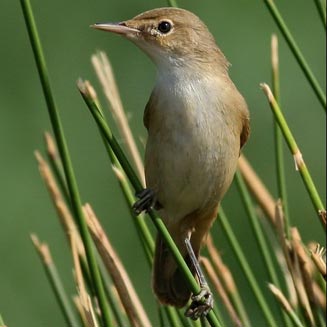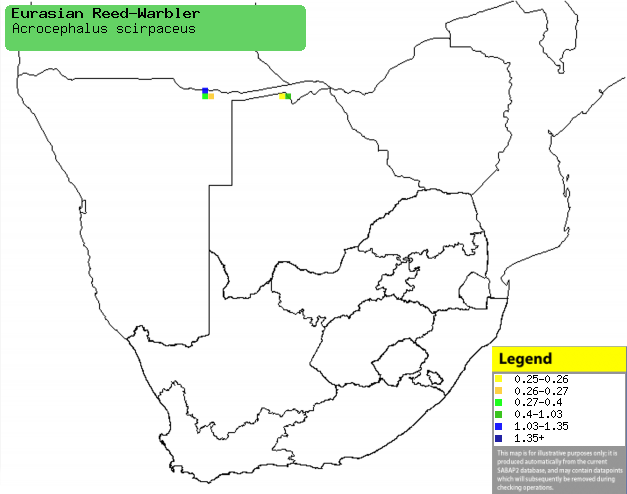|
Acrocephalus scirpaceus
(Eurasian reed-warbler, European reed-warbler)
Hermanse rietsanger [Afrikaans]; Kleine karekiet [Dutch];
Rousserolle effarvatte [French]; Teichrohrsänger [German];
Rouxinol-pequeno-dos-caniços [Portuguese]
Life
> Eukaryotes >
Opisthokonta
> Metazoa (animals) >
Bilateria >
Deuterostomia > Chordata >
Craniata > Vertebrata (vertebrates) > Gnathostomata (jawed
vertebrates) > Teleostomi (teleost fish) > Osteichthyes (bony fish) > Class:
Sarcopterygii (lobe-finned
fish) > Stegocephalia (terrestrial
vertebrates) > Tetrapoda
(four-legged vertebrates) > Reptiliomorpha > Amniota >
Reptilia (reptiles) >
Romeriida > Diapsida > Archosauromorpha > Archosauria >
Dinosauria
(dinosaurs) > Saurischia > Theropoda (bipedal predatory dinosaurs) >
Coelurosauria > Maniraptora > Aves
(birds) > Order: Passeriformes
> Family: Sylviidae > Genus: Acrocephalus
 |
|
|
European reed-warbler, Kuwait. [photo
rashed1112
©] |
|
Distribution and habitat
Its breeding grounds stretch from north Africa to Europe
and Russia; in the non-breeding season it heads south to sub-Saharan Africa,
where it occurs from Senegal to Ethiopia south through the DRC to Zambia and
southern Africa. Here it is fairly common in certain localities of the Caprivi
Strip and northern Botswana, but much more rare in Zimbabwe, south-eastern
Botswana and South Africa.
|
 |
|
Distribution of Eurasian reed-warbler in southern Africa,
based on statistical smoothing of the records from first SA Bird Atlas
Project (©
Animal Demography unit, University of
Cape Town; smoothing by Birgit Erni and Francesca Little). Colours range
from dark blue (most common) through to yellow (least common). |
Movements and migrations
It arrives in Kenya and Uganda around
November-January, with most records from Botswana in late November
to December, leaving from March to early April.
Food
It mainly eats insects such as termite alates and
mosquitoes, doing most of its foraging in the reedbed but occasionally taking
prey from the ground or surface.
Threats
Not threatened, its European breeding population is thought
to be several million.
References
-
Hockey PAR, Dean WRJ and Ryan PG 2005. Roberts
- Birds of southern Africa, VIIth ed. The Trustees of the John Voelcker
Bird Book Fund, Cape Town.
-
Harrison, J.A., Allan, D.G., Underhill, L.G., Herremans, M.,
Tree. A.J., Parker, V. & Brown, C.J. (eds). 1997. The atlas of southern
African birds. Vol. 2: Passerines. BirdLife South Africa, Johannesburg.
|
